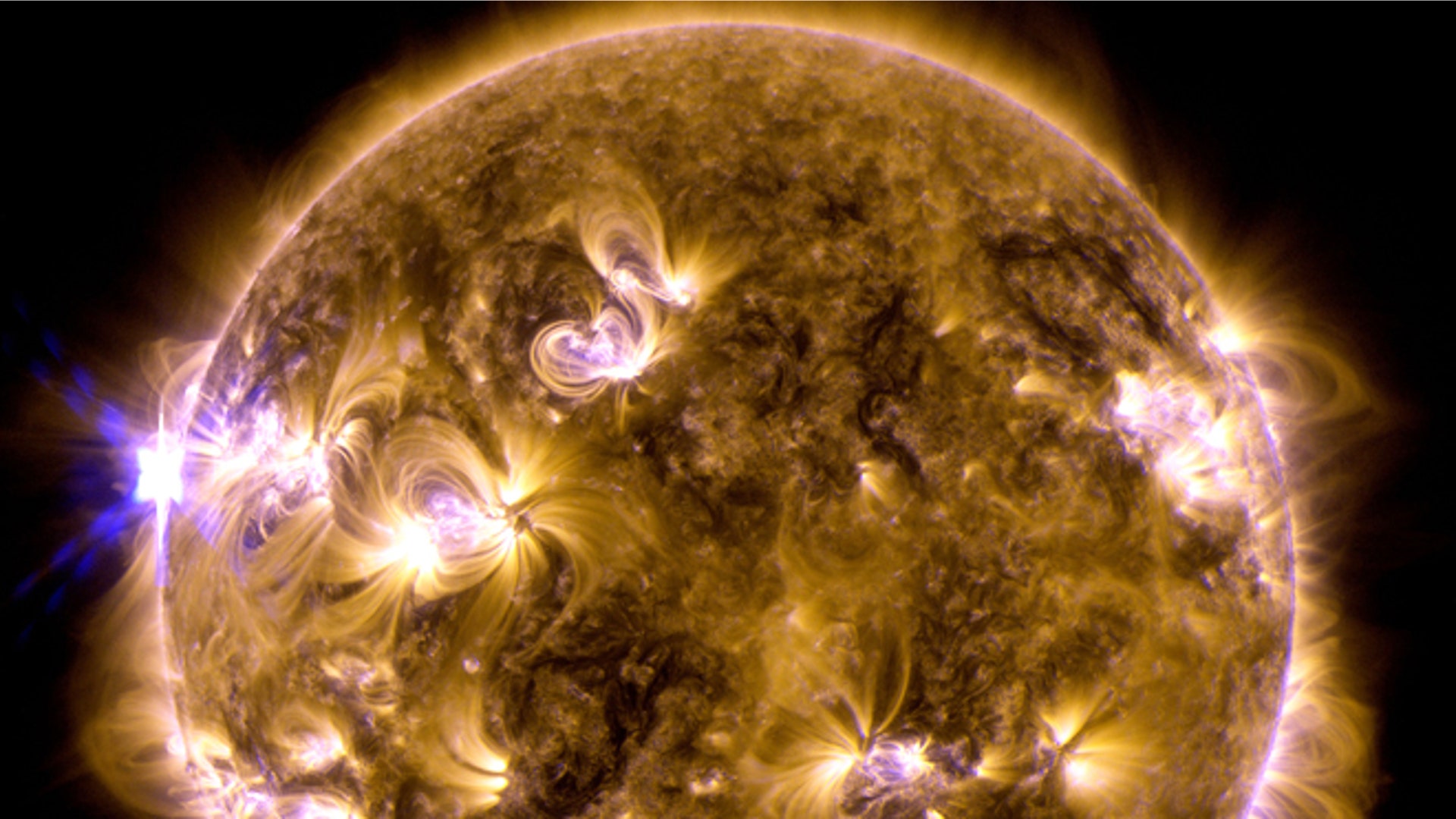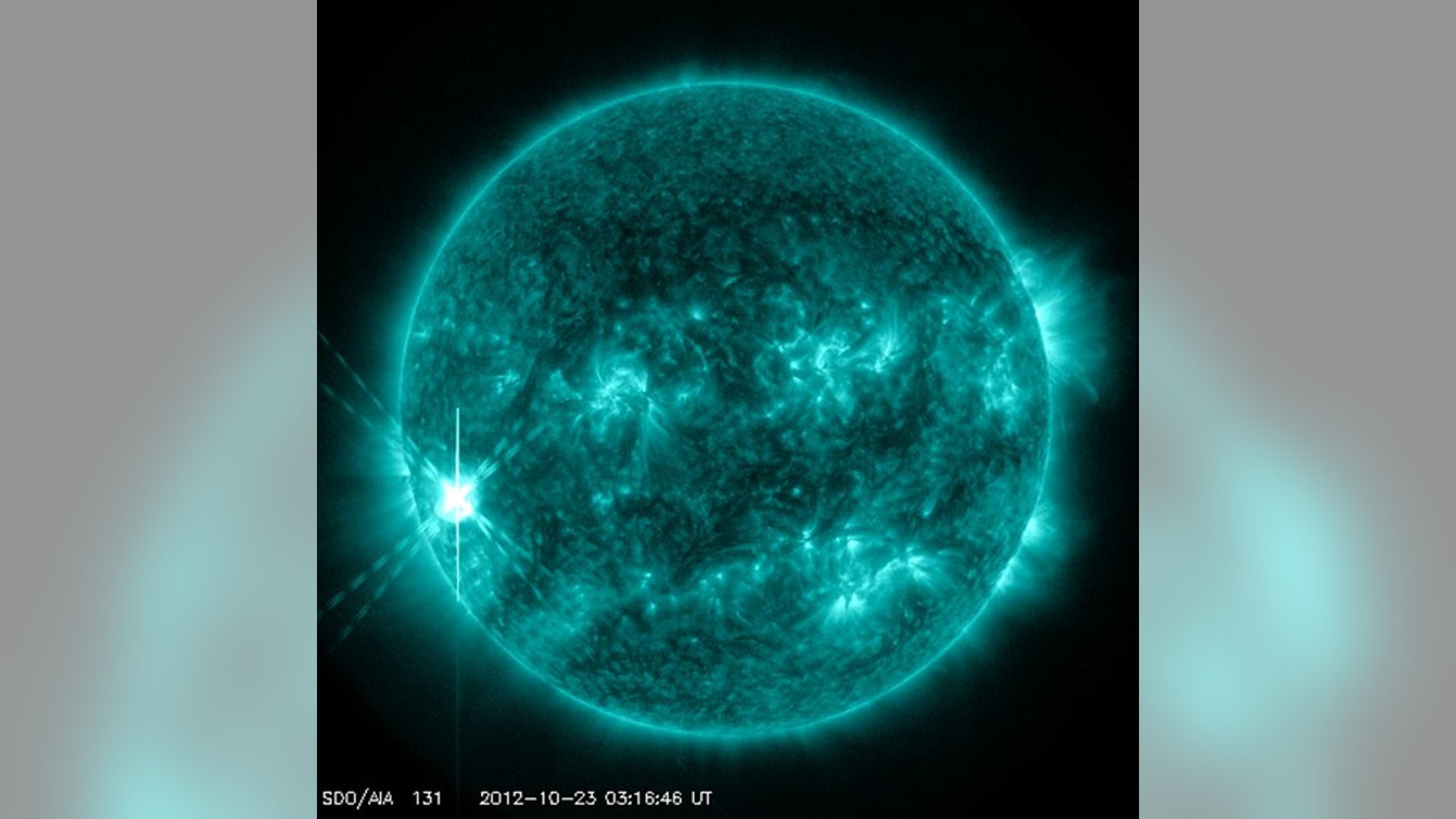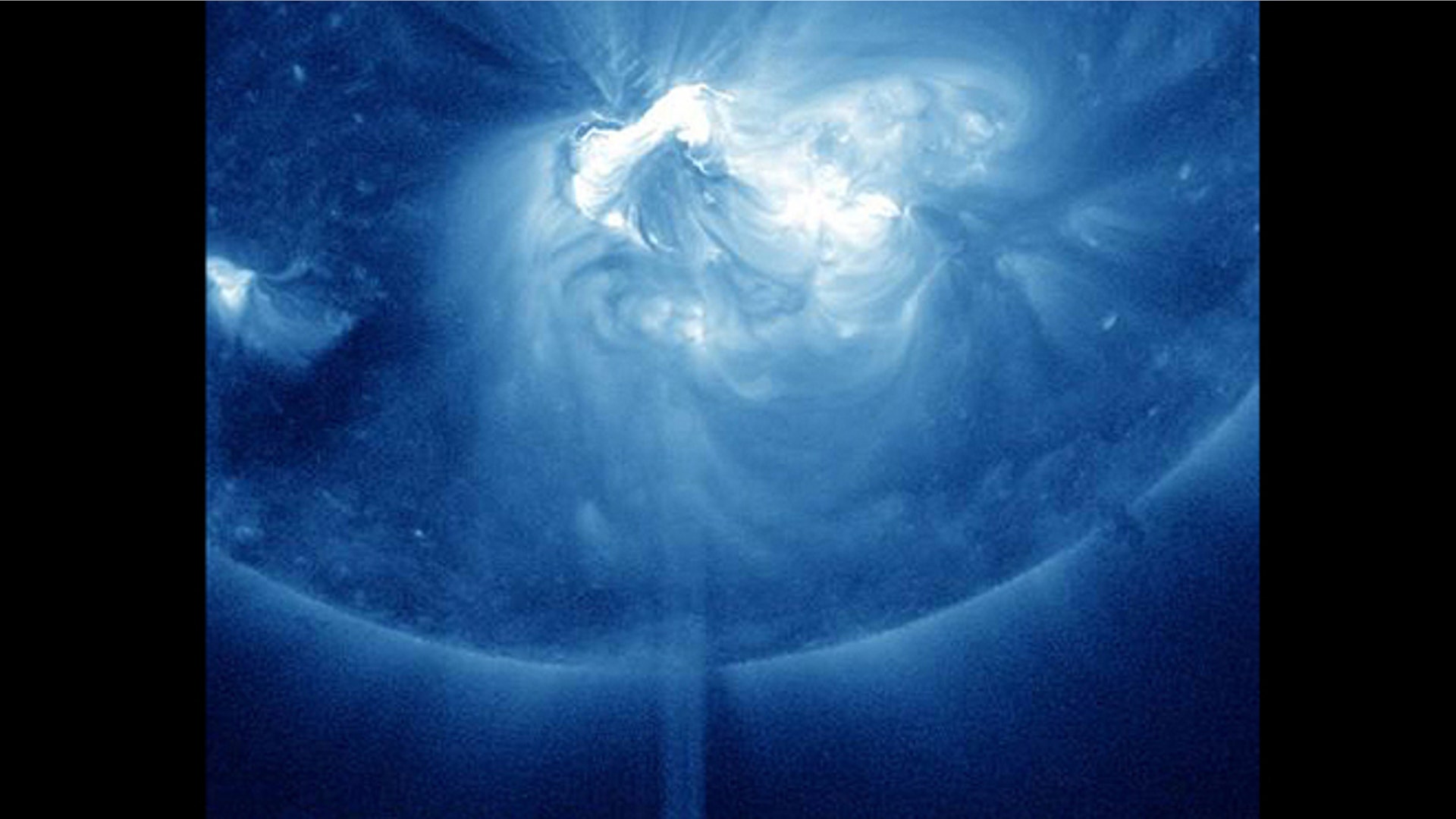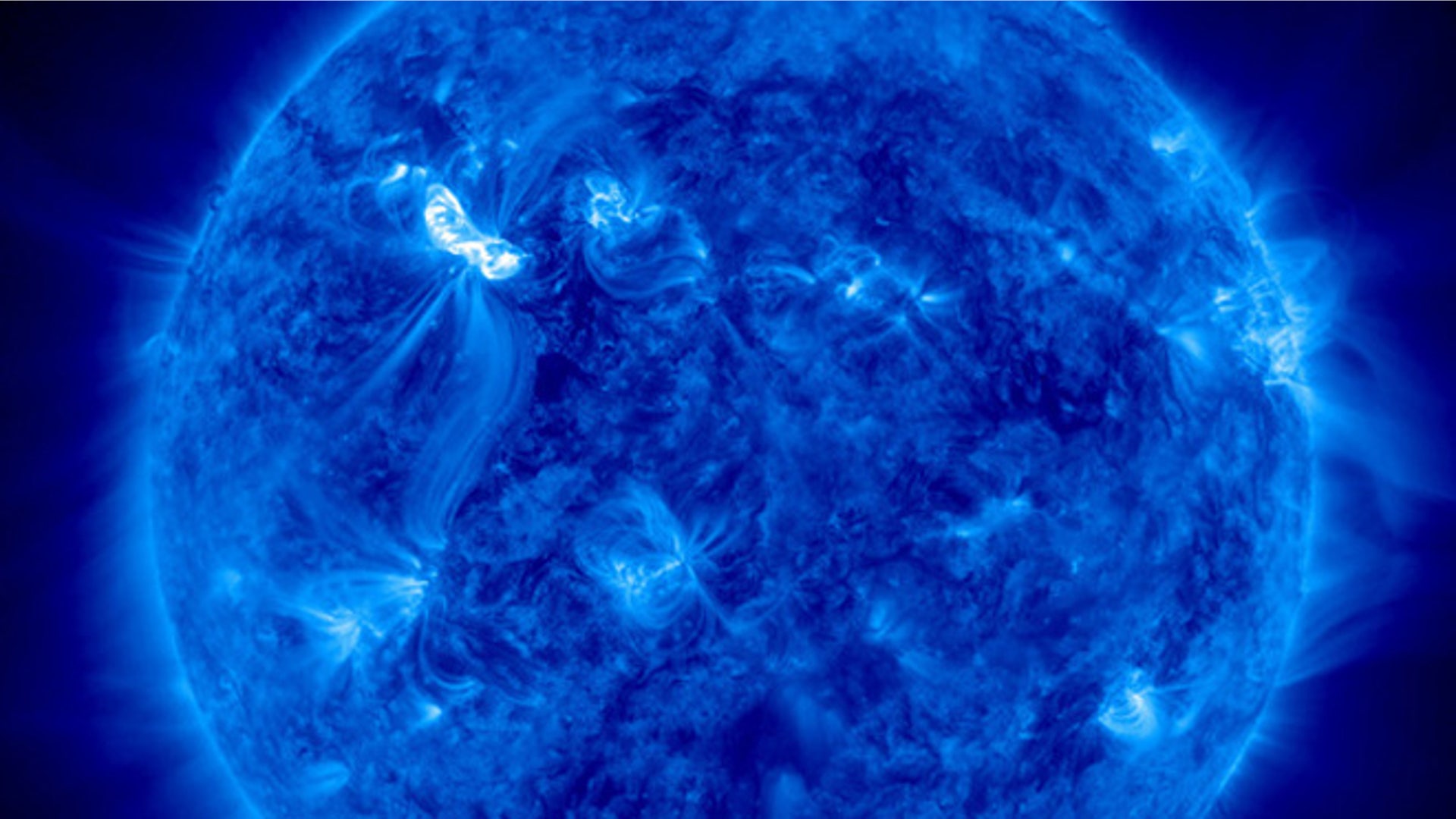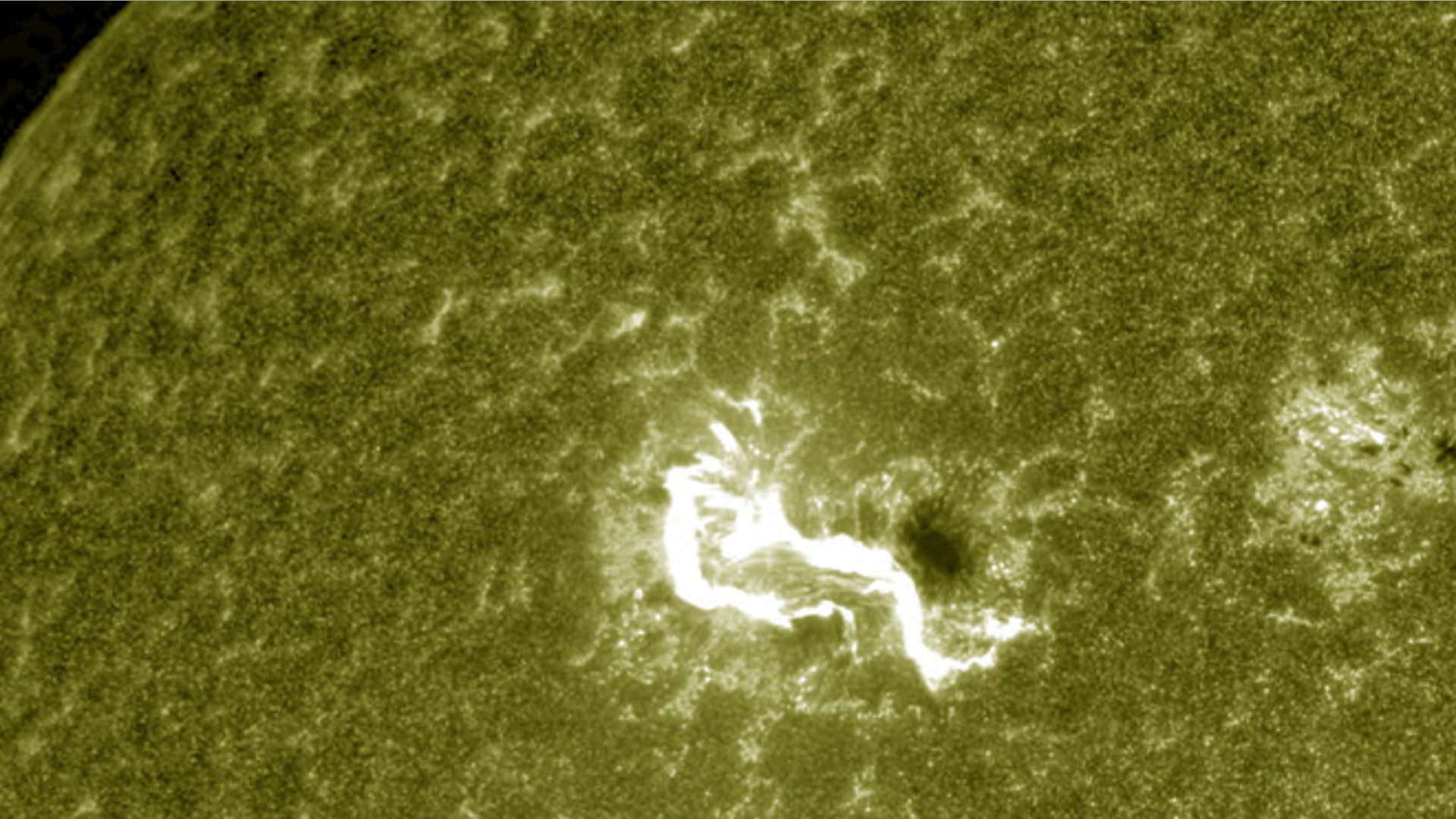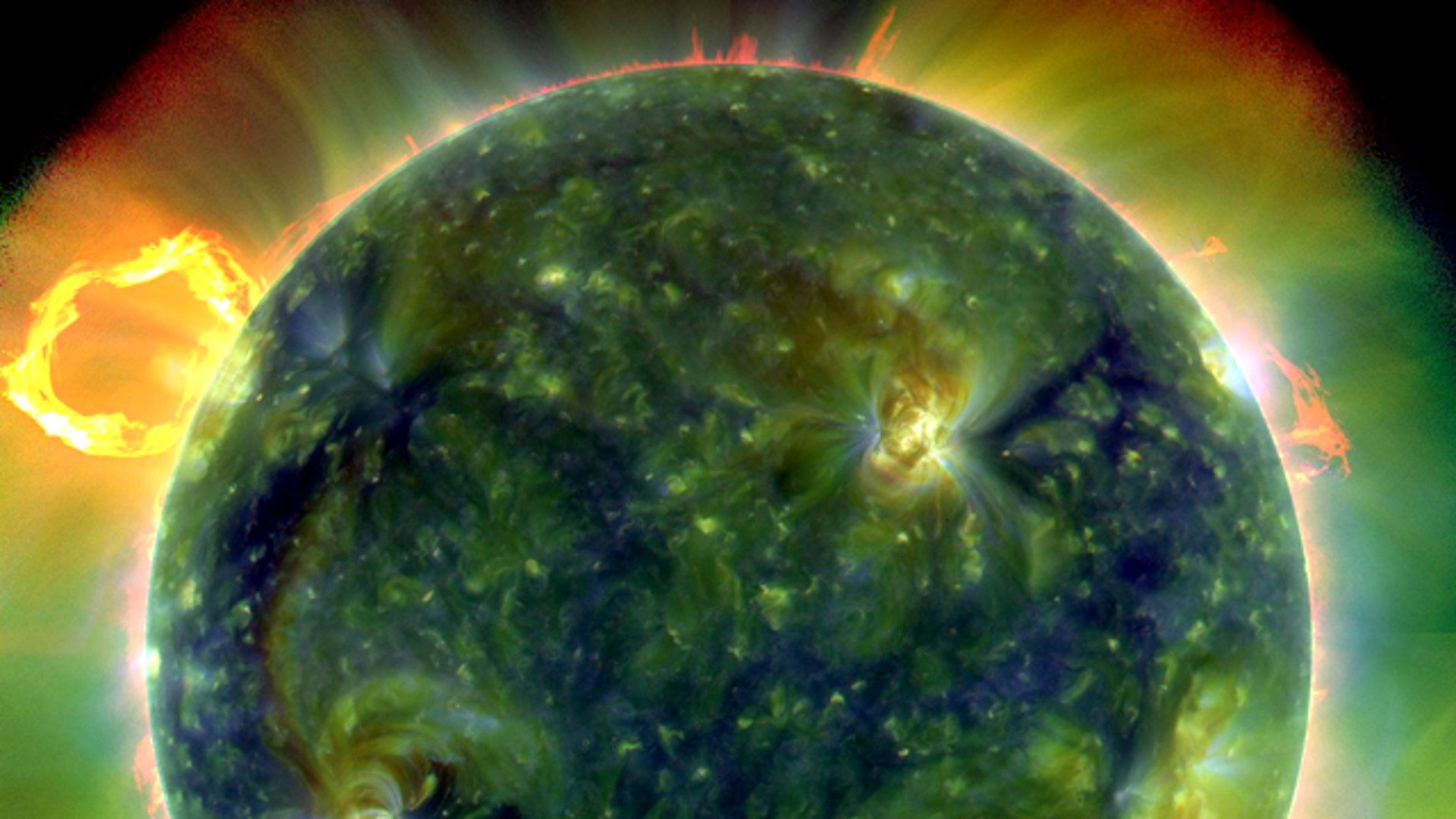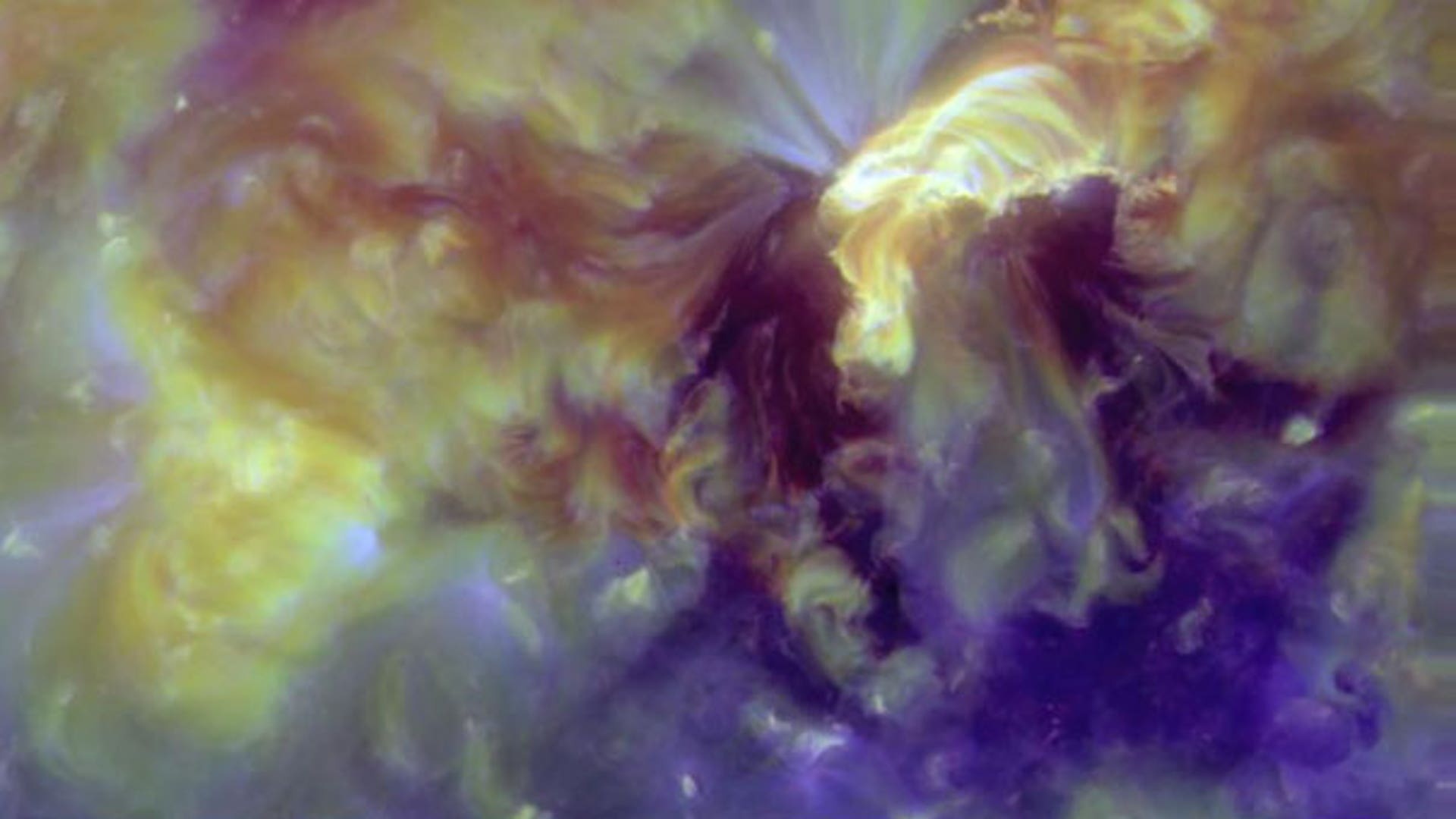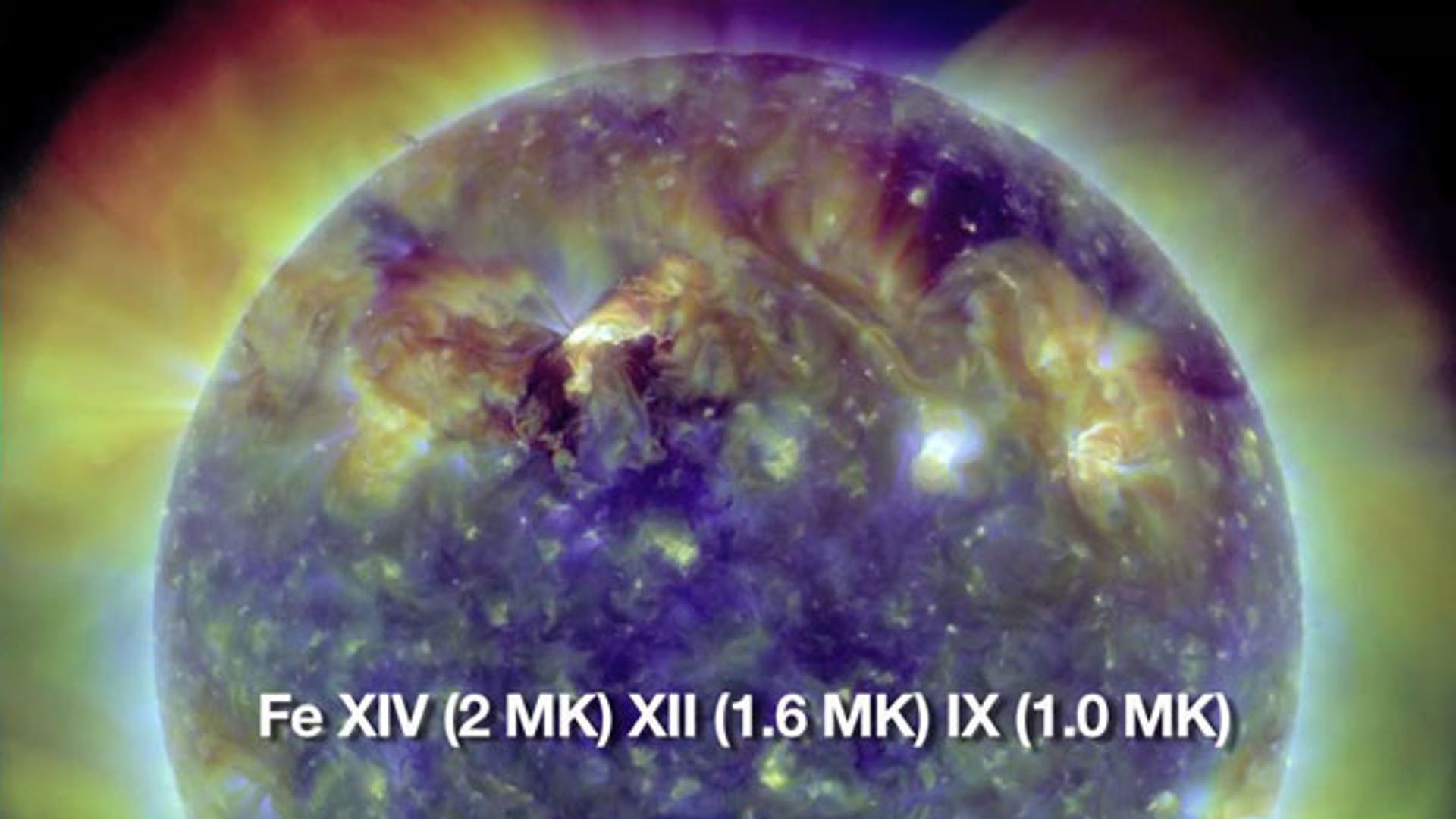Move Back
ADVERTISEMENT
Skip- Published22 Images
The sun as you've never seen it before
Eruptions on the sun's surface can blast tons of plasma into space -- sometimes right at the Earth. Astonishing pictures show the giant flares and clouds of ionized gas erupting from the star.
![Biggest_Solar_Flare_2013]() May 12, 2013: This blend of two images taken by NASAs Solar Dynamics Observatory shows a solar eruption. One image shows light in the 171-angstrom wavelength, the other in 131 angstroms. Scientists say the Mothers Day solar flare was the strongest of the year and occurred on the side of the sun that faced away from Earth. Read moreread moreAP Photo/NASA's Solar Dynamics ObservatoryShare
May 12, 2013: This blend of two images taken by NASAs Solar Dynamics Observatory shows a solar eruption. One image shows light in the 171-angstrom wavelength, the other in 131 angstroms. Scientists say the Mothers Day solar flare was the strongest of the year and occurred on the side of the sun that faced away from Earth. Read moreread moreAP Photo/NASA's Solar Dynamics ObservatoryShare![solar_flare_april_11_2013_full]()
![solar_flare]()
![ar_1520_x14_flare_new]()
![m2_class_solar_flare]()
![x_class_solar_flare_march_6_2012]()
![x_class_flare_sdo_march_7_2012]()
![Sun_Waking_Up]() NASA's Solar Dynamics Observatory snapped this X-ray photo of the Sun early in the morning of Sunday, August 1st. The dark arc near the top right edge of the image is a filament of plasma blasting off the surface -- part of the coronal mass ejection. The bright region is an unassociated solar flare. When particles from the eruption reached the Earth, they triggered a brilliant auroral display known as the Northern Lights.read moreNASAShare
NASA's Solar Dynamics Observatory snapped this X-ray photo of the Sun early in the morning of Sunday, August 1st. The dark arc near the top right edge of the image is a filament of plasma blasting off the surface -- part of the coronal mass ejection. The bright region is an unassociated solar flare. When particles from the eruption reached the Earth, they triggered a brilliant auroral display known as the Northern Lights.read moreNASAShare![Here Comes the Sun]() An extreme ultraviolet image of the sun taken by Space Dynamics Observatory on March 30, 2010. Reds are relatively cool (about 107,540 Fahrenheit); blues and greens are hotter (greater than 1.8 million Fahrenheit). Click here to see the hi-resolution image from NASA.read moreNASA/Goddard Space Flight Center Scientific Visualization StudioShare
An extreme ultraviolet image of the sun taken by Space Dynamics Observatory on March 30, 2010. Reds are relatively cool (about 107,540 Fahrenheit); blues and greens are hotter (greater than 1.8 million Fahrenheit). Click here to see the hi-resolution image from NASA.read moreNASA/Goddard Space Flight Center Scientific Visualization StudioShare![Solar Prominence]() An image of the sun moments before a twisting solar prominence erupts on March 30, 2010. Images and videos taken by the SDO give evidence of the dynamic sun never before seen by NASA's scientists. Click here to see the full video from NASA.read moreNASA/Goddard Space Flight Center Scientific Visualization StudioShare
An image of the sun moments before a twisting solar prominence erupts on March 30, 2010. Images and videos taken by the SDO give evidence of the dynamic sun never before seen by NASA's scientists. Click here to see the full video from NASA.read moreNASA/Goddard Space Flight Center Scientific Visualization StudioShare![Solar Prominence]() An image of a twisting solar prominence eruption taken on March 30, 2010. Images and videos taken by the SDO give evidence of the dynamic sun never before seen by NASA's scientists. Click here to see the full video from NASA.read moreNASA/Goddard Space Flight Center Scientific Visualization StudioShare
An image of a twisting solar prominence eruption taken on March 30, 2010. Images and videos taken by the SDO give evidence of the dynamic sun never before seen by NASA's scientists. Click here to see the full video from NASA.read moreNASA/Goddard Space Flight Center Scientific Visualization StudioShare![Solar Prominence]() Launched on Feb. 11, 2010, the SDO is the most advanced spacecraft ever designed to study the sun. During its five-year mission, it will examine the sun's magnetic field and also provide a better understanding of the role the sun plays in Earth's atmospheric chemistry and climate.read moreNASA/Goddard Space Flight Center Scientific Visualization StudioShare
Launched on Feb. 11, 2010, the SDO is the most advanced spacecraft ever designed to study the sun. During its five-year mission, it will examine the sun's magnetic field and also provide a better understanding of the role the sun plays in Earth's atmospheric chemistry and climate.read moreNASA/Goddard Space Flight Center Scientific Visualization StudioShare![Solar Prominence]() SDO will determine how the sun's magnetic field is generated, structured and converted into violent solar events such as turbulent solar wind, solar flares and coronal mass ejections. These immense clouds of material, when directed toward Earth, can cause large magnetic storms in our planet’s magnetosphere and upper atmosphere.read moreNASA/Goddard Space Flight Center Scientific Visualization StudioShare
SDO will determine how the sun's magnetic field is generated, structured and converted into violent solar events such as turbulent solar wind, solar flares and coronal mass ejections. These immense clouds of material, when directed toward Earth, can cause large magnetic storms in our planet’s magnetosphere and upper atmosphere.read moreNASA/Goddard Space Flight Center Scientific Visualization StudioShare![Early Images]() One of the first images captured by the Atmospheric Imaging Assembly. After the devices used to translate the light cast off by the sun cooled down, this image was taken of a solar eruption on March 30, one of the first visible events. Click here to see the full video from NASA.read moreNASA/Goddard Space Flight Center Scientific Visualization StudioShare
One of the first images captured by the Atmospheric Imaging Assembly. After the devices used to translate the light cast off by the sun cooled down, this image was taken of a solar eruption on March 30, one of the first visible events. Click here to see the full video from NASA.read moreNASA/Goddard Space Flight Center Scientific Visualization StudioShare![Blue Sun]() One of the first images captured by the Atmospheric Imaging Assembly. After the devices used to translate the light cast off by the sun cooled down, this image was taken of a solar eruption on March 30, one of the first visible events. Click here to see the full video from NASA.read moreNASA/Goddard Space Flight Center Scientific Visualization StudioShare
One of the first images captured by the Atmospheric Imaging Assembly. After the devices used to translate the light cast off by the sun cooled down, this image was taken of a solar eruption on March 30, one of the first visible events. Click here to see the full video from NASA.read moreNASA/Goddard Space Flight Center Scientific Visualization StudioShare![Atmospheric Imaging Assembly]()
![Heating and Cooling]() An extreme ultraviolet image of the sun taken by the SDO satellite on March 30 shows areas of heating and cooling on the sun. Reds are relatively cool (about 107,540 Fahrenheit); blues and greens are hotter (greater than 1.8 million Fahrenheit).read moreNASA/Goddard Space Flight Center Scientific Visualization StudioShare
An extreme ultraviolet image of the sun taken by the SDO satellite on March 30 shows areas of heating and cooling on the sun. Reds are relatively cool (about 107,540 Fahrenheit); blues and greens are hotter (greater than 1.8 million Fahrenheit).read moreNASA/Goddard Space Flight Center Scientific Visualization StudioShare![Cool Sun]() Richard Fisher, director of the Heliophysics Division at NASA Headquarters in Washington, said the new satellite shows a view of the sun he hasn't seen in over 40 years of research. "SDO will change our understanding of the sun and its processes, which affect our lives and society. This mission will have a huge impact on science, similar to the impact of the Hubble Space Telescope on modern astrophysics.”read moreNASA/Goddard Space Flight Center Scientific Visualization StudioShare
Richard Fisher, director of the Heliophysics Division at NASA Headquarters in Washington, said the new satellite shows a view of the sun he hasn't seen in over 40 years of research. "SDO will change our understanding of the sun and its processes, which affect our lives and society. This mission will have a huge impact on science, similar to the impact of the Hubble Space Telescope on modern astrophysics.”read moreNASA/Goddard Space Flight Center Scientific Visualization StudioShare![Hot Sun]() Space weather has been recognized as a cause of technological problems since the invention of the telegraph in the 19th century. These events produce disturbances in electromagnetic fields on Earth that can induce extreme currents in wires, disrupting power lines and causing widespread blackouts. And SDO can help measure those disturbances far more accurately than ever before.read moreNASA/Goddard Space Flight Center Scientific Visualization StudioShare
Space weather has been recognized as a cause of technological problems since the invention of the telegraph in the 19th century. These events produce disturbances in electromagnetic fields on Earth that can induce extreme currents in wires, disrupting power lines and causing widespread blackouts. And SDO can help measure those disturbances far more accurately than ever before.read moreNASA/Goddard Space Flight Center Scientific Visualization StudioShare![Heating and Cooling]() An extreme ultraviolet image of the sun taken by the SDO satellite on March 30 shows areas of heating and cooling on the sun. Reds are relatively cool (about 107,540 Fahrenheit); blues and greens are hotter (greater than 1.8 million Fahrenheit).read moreNASA/Goddard Space Flight Center Scientific Visualization StudioShare
An extreme ultraviolet image of the sun taken by the SDO satellite on March 30 shows areas of heating and cooling on the sun. Reds are relatively cool (about 107,540 Fahrenheit); blues and greens are hotter (greater than 1.8 million Fahrenheit).read moreNASA/Goddard Space Flight Center Scientific Visualization StudioShare![Cool Sun]() Richard Fisher, director of the Heliophysics Division at NASA Headquarters in Washington, said the new satellite shows a view of the sun he hasn't seen in over 40 years of research. "SDO will change our understanding of the sun and its processes, which affect our lives and society. This mission will have a huge impact on science, similar to the impact of the Hubble Space Telescope on modern astrophysics.”read moreNASA/Goddard Space Flight Center Scientific Visualization StudioShare
Richard Fisher, director of the Heliophysics Division at NASA Headquarters in Washington, said the new satellite shows a view of the sun he hasn't seen in over 40 years of research. "SDO will change our understanding of the sun and its processes, which affect our lives and society. This mission will have a huge impact on science, similar to the impact of the Hubble Space Telescope on modern astrophysics.”read moreNASA/Goddard Space Flight Center Scientific Visualization StudioShare![Hot Sun]() Space weather has been recognized as a cause of technological problems since the invention of the telegraph in the 19th century. These events produce disturbances in electromagnetic fields on Earth that can induce extreme currents in wires, disrupting power lines and causing widespread blackouts. And SDO can help measure those disturbances far more accurately than ever before.read moreNASA/Goddard Space Flight Center Scientific Visualization StudioShare
Space weather has been recognized as a cause of technological problems since the invention of the telegraph in the 19th century. These events produce disturbances in electromagnetic fields on Earth that can induce extreme currents in wires, disrupting power lines and causing widespread blackouts. And SDO can help measure those disturbances far more accurately than ever before.read moreNASA/Goddard Space Flight Center Scientific Visualization StudioShare- Published22 Images
The sun as you've never seen it before
Eruptions on the sun's surface can blast tons of plasma into space -- sometimes right at the Earth. Astonishing pictures show the giant flares and clouds of ionized gas erupting from the star.
Move Forward
- The sun as you've never seen it before






















Thumbnail View
Image 0 of 22
